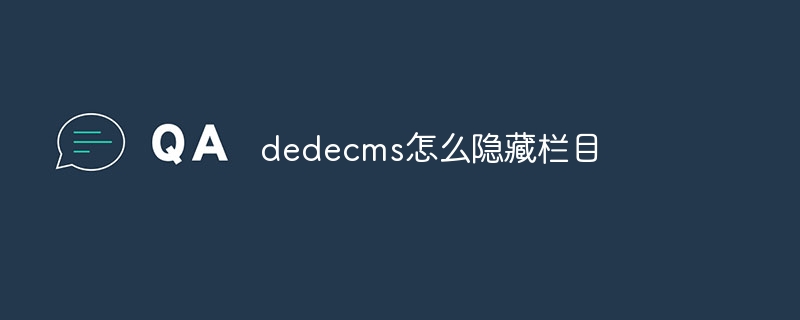Home >Common Problem >How to hide columns in dedecms
How to hide columns in dedecms
- 百草Original
- 2023-07-13 16:20:131425browse
Methods for dedecms to hide columns: 1. Use member groups to control access rights. dedecms has a built-in membership system that can set different access rights according to different member groups; 2. Use roles to control access rights and give roles Assign corresponding permissions so that only users in this role can access the hidden columns; 3. Use a custom template to control access permissions. Only users who have accessed the custom template can see the hidden columns.

The operating system of this tutorial: Windows 10 system, DedeCMS version 5.7.110, Dell G3 computer.
DedeCMS is a powerful content management system that can easily create and manage various websites. In the process of building a website, sometimes it is necessary to hide certain columns in order to control access under specific circumstances. This article will introduce the method of hiding columns in DedeCMS.
The purpose of hiding a column is to control access to the column so that only specific users or roles can access the content in the column. This is very useful in some specific scenarios. For example, for websites with paid content, only subscribed users can access hidden columns, while ordinary users cannot obtain the content.
DedeCMS provides a variety of ways to hide columns. These methods will be introduced one by one below.
1. Use member groups to control access rights
DedeCMS has a built-in membership system that can set different access rights according to different member groups. By adjusting the permission settings of the member group, you can control access to the column. The specific steps are as follows:
- Log in to the website backend management system and enter the "Members->Member Group Management" page.
- Create a new member group, such as "VIP members".
- In the "Member Group Management" page, select the "Function Permission Control" option and check "Browse Permission (column)".
- Enter the "Column Management" page, select the column that needs to be hidden, and check the "Limited to VIP member group access" option.
- After saving the settings, only users belonging to the "VIP Members" group can access the hidden columns.
2. Use roles to control access rights
DedeCMS also supports controlling column access rights through roles. Roles can be understood as a collection of users. By assigning corresponding permissions to roles, columns can be hidden. The specific steps are as follows:
- Log in to the website backend management system and enter the "Website->Role Management" page.
- Create a new role, such as "Editor".
- In the "Permission Assignment" page, check the columns that need to be hidden.
- Assign a role to the corresponding user. Only users with this role can access the hidden columns.
3. Use custom templates to control access permissions
DedeCMS can also hide columns based on custom templates. The specific steps are as follows:
- Log in to the website backend management system and enter the "Column Management" page.
- Select the column you want to hide and click "Column Properties".
- Enter the template name in the "Custom Template" column and save the settings.
- Create the corresponding template file in the template folder of the website and add the access control code in it.
- Only users who have accessed the custom template can see the hidden columns.
Through the above methods, the hiding and access control of columns in DedeCMS can be easily achieved. According to actual needs, choosing an appropriate method to hide the column can better protect the security and uniqueness of the website content.
The above is the detailed content of How to hide columns in dedecms. For more information, please follow other related articles on the PHP Chinese website!

